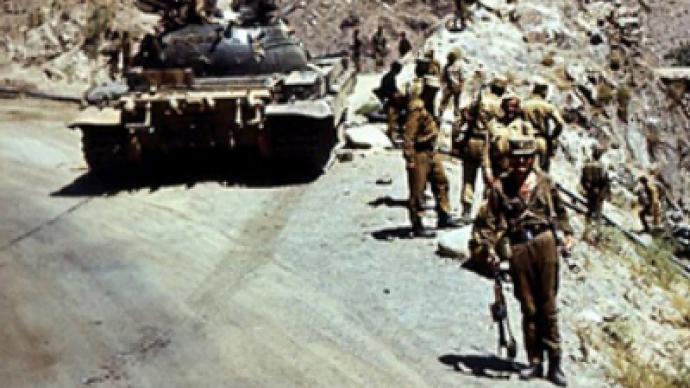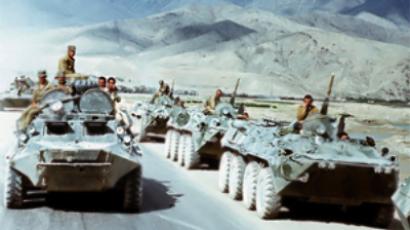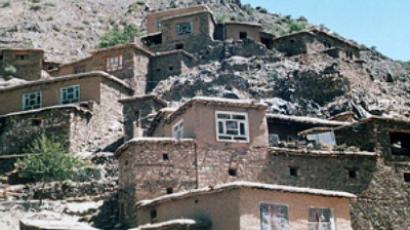Soviet-Afghani stalemate: military success – political failure

Even though Soviet troops pulled out of Afghanistan twenty years ago without tasting a single significant defeat, they were unable to bring peace to Afghanistan.
The stumbling block
The first military leader, who stumbled upon Afghanistan as early as 320 BCE was none other than Alexander the Great. After an easy invasion of Iran, his forces were massively troubled while gaining control over the mountainous region that some 2,000 years later became known as Afghanistan.
Having no humanitarian boundaries like the Geneva Convention, Alexander eventually conquered the land, though it took him some three years.
Since then the country spent more then twenty centuries as a feudal state, only to start changing regimes in quick succession in the 1970s.
When a bloodless coup d’état made Afghanistan a democracy in 1973, the Soviet Union felt the serious potential of a socialist movement forming in its southeastern neighbour and started to build special relations with it. Since early 1978, thousands of Soviet civilian advisers moved to Afghanistan to support the country’s development.
In a very short time the country’s socialistic party – the People's Democratic Party of Afghanistan (PDPA) – had an edge in the Afghani political system. Yet another revolution in April 1979 saw the PDPA coming to power in Afghanistan.
The extremely religious Afghani society was clearly not ready to accept the socialist ideology. Civil uprisings started to erupt across the country. After more then twenty calls to intervene, initially reluctant Soviet leader Leonid Brezhnev agreed to send Soviet forces into Afghanistan.
To the rescue
Colonel Eugene Khrushchev, former First Secretary of the Russian Embassy in the Islamic Republic of Afghanistan, sees a very clear ‘personal’ reason behind Brezhnev’s decision.
In September 1979, just five months into the Afghani socialistic revolution Brezhnev had a very reassuring visit from the President of Afghanistan Nur Muhammad Taraki. Very soon Taraki was replaced at the country’s head by Prime-Minister Hafizullah Amin.
«[Amin’s actions] were a personal insult to Brezhnev. When Taraki was coming back from Cuba, he made a stopover in Moscow and had a very friendly conversation with Brezhnev and assured him that everything would be just fine in Afghanistan, and just four days later the Afghan leader was murdered by Amin [who took his place],» Khrushchev says.
Officially Amin announced in December that Taraki died of an illness. It is believed that there was another issue that affected Brezhnev’s decision.
Some believe that the Soviet leader had his first heart attack when he learnt that fifty Soviet military advisers were killed during the March 1979 uprising in the Heart province. According to some reports their heads were stacked on wooden posts on the road from Herat to the Soviet border.
On December 12, 1979, it was official: the Soviet Union was to send its Limited Armed Contingent to Afghanistan. In 13 days the first forces crossed their border.
Surprise first target
The first operation that was conducted on Afghani soil was Storm-333, aimed at the extermination of Hafizullah Amin, the most vocal welcomer of Soviet forces.
Khrushchev believes Amin was a double-agent, as did the Soviet leaders, who were preparing to replace Amin with his Prime-Minister Babrak Karmal.
“In the Soviet intelligence community, we had circumstantial evidence that Amin was recruited by the CIA when he was the head of Afghan expats in the U.S. He was assigned to penetrate the Afghan leadership. In my view, he was the Afghan Saakashvili. His purpose was to radicalise Afghanistan from within, to split the PDPA into factions, and to provoke the backlash from fundamentalists to have an excuse to invite Soviet troops. So, on the skin deep analysis he might look like a soviet ally. But, in a way, he did everything to compromise and discredit the Soviet civilian and military assistance to Afghanistan and by his brutal policy and assassination campaign, which included his teacher Taraki (who brought him into the circle of the PDPA), he alienated everybody, except the United States. Most importantly he alienated the PDPA and the general population of Afghanistan. This alienation was skillfully exploited and manipulated by the CIA and Interservice Agency of Pakistan, as a result of which the Soviet Union was drawn into the trap of a civil war, which was later exacerbated by the insurgency where the Soviet Union had to support the minority in Afghanistan. He was an agent provocateur. If it were not for him, we wouldn't have had these ten years of a bloody military campaign,” Khrushchev says.
According to Khrushchev there were two attempts to assassinate Amin by Soviet intelligence. First they tried to ambush him in his car, but he miraculously escaped. Another attempt was on the afternoon of December 27, 1979. At a dinner party his Uzbek cooks laced his food with poison.
Ironically enough, being unaware of the assassination plans, Soviet doctors rushed in and saved his life. For this case Soviet forces had a Plan B: storm the Presidential Palace.
At 7:30 PM the operation kicked off. At 8:45 PM Karmal’s pre-recorded address to the nation was broadcast over Afghani radio, which meant Amin’s end and Karmal’s position as the leader of the state.
“The storming of the palace was a textbook operation which is studied by Special Forces all over the world. It was an incredible success, though I have to admit we had the most casualties due to friendly fire. During this operation, in the heat of the storm, it was not quite clear who was fighting with whom or against whom. Plus, part of our Special Forces were clad in afghan uniform so it was in a way it was incredible that such a small number of Special Forces died in this operation,” – Khrushchev says, adding, – “During the storming, Amin displayed enough courage to defend himself and his family with an AK-47. So in a way, he died like a soldier, without begging for mercy”.
New player enters
Initial military successes of the Soviet forces by the middle of 1980 were marred by the inability of the PDPA to establish civil control over the towns and provinces that were secured by the Soviet forces.
PDPA’s control was often nominal, maintained only at daytime, while at night everything was in the hands of the Mujaheddin.
What had even more impact on the course of the conflict was the April decision of the U.S. Congress to aid the Mujaheddin. From $US 5 million a year their financial aid was rapidly increased to $US 1-1.7 billion a year. This is comparable to Soviet expenses that by the boldest estimates didn’t exceed $US 3.8 billion (including the financial aid to PDPA).
“The Soviet military campaign in Afghanistan was in fact a U.S. proxy war against the Soviet Union, which was presented, re-packaged for the world public opinion as a Jihad against the Soviet occupant infidels. And it was one of the major challenges for the Soviet political leadership and for the Soviet diplomatic corps. They never managed to dissuade or change the world public opinion that it was not the case. The Soviet Union had a totally different objective and agenda: only as a minimum to prevent the chaos and fundamental extremists taking power in Kabul, or Afghanistan falling into the hands of the United States and converting and turning Afghanistan into another Pakistan, which was the ally of the United States, and thus threatening the Soviet Union’s southern border,” Khrushchev observes.
Fuelled by U.S. money the number of Mujaheddin started to surge dramatically. From 8,500 in 1981 it reached 50,000 by spring 1982 and 150,000 in 1986. Not only did Americans supply the Mujaheddin with money, but also with newest arms including Soviet ones acquired from the black market.
“The CIA started funneling the Swedish Oerlikon surface-to-air missiles in 1984. Then in 1985 they started supplying British Blowpipe shoulder-fired missiles and – for the first time – notorious U.S.-made Stinger missiles,” Khrushchev says.
This put the Mujaheddin in a position to break the Soviet supremacy in the air, while on the ground the Soviet technical supremacy was minimised by the mountainous Afghani terrain.
Change of course
Meanwhile, Mikhail Gorbachev came to power in 1985, bringing substantial changes to Soviet policy in Afghanistan. At the Politburo session in 1986 he notoriously declared: “We are fighting for six years, and without a change of approach may well fight for another thirty.”
Khrushchev, who was in Afghanistan at the time, sees Gorbachev’s approach as defeatist.
“One American Colonel told a Vietnamese Colonel that the U.S. didn’t lose one battle in Vietnam. The Vietnamese Colonel responded that to him that was irrelevant. I think it would be correct to use the same analogy to the Soviet-Mujaheddin war in the way that we didn’t lose any battle, though sometimes, we didn’t win them either, for sure we didn't lose them. But the soviet tactical military success was null and void by the political decision made in Moscow by Gorbachev,” Khrushchev says.
Though the planned military operations conducted by Soviet forces were no less successful than on the early stages of the campaign, the 1988 campaign was all about planning the troops’ withdrawal. PDPA called to delay the withdrawal, but Gorbachev was determined to have the last soldier out of Afghanistan by early 1989. February 15 turned out to be the date.
Despite the opposition controlling 60 per cent of Afghani territory in 1988 already, the PDPA managed to stay in power for another three years, till the newly-emerged Taliban movement claimed Afghanistan.
At its peak the Limited Contingent of Soviet troops in Afghanistan was 100,300-soldiers-strong.
The vast experience generated by a military involvement of this scale became a basis for NATO’s strategy in Afghanistan.
Back in November 2001, when the latest conflict in Afghanistan was in its early stages, U.S. Secretary of State stated: “We have learned a lot from the Soviet army’s experience in Afghanistan”.
Russian Prime Minister Vladimir Putin had even considered a return of Russian military to Afghanistan in exchange for Georgia and Ukraine not entering NATO. The idea was abandoned in March 2008.
Major operations of the Soviet-Mujaheddin war
Storm-333 (December, 1979)
Objective: storm the Tajbeg Palace, exterminate 2nd President of Democratic Republic Hafizullah Amin;
Outcome: exemplary success;
Soviet casualties: 5 dead, 35 wounded.
Deblocking Nahrin (January, 1980)
Objective: remove the blockade of Nahrin village where local artillery unit was involved in revolt;
Outcome: success;
Soviet casualties: 5 dead.
The Kunar offensive (March, 1980)
Objective: hinder the penetration of the Mujaheddin from Pakistan, clear the northeastern Badakhshan province;
Outcome: pushing the insurgents to Pakistan was completed quickly, but the success of the first major military operation wasn’t maintained later;
Soviet casualties: undisclosed.
The Blow (November, 1980; February, 1987)
Objective: establish as much control as possible over regions neighbouring Kabul;
Outcome: considerable breakthrough in the first phase, overall success in the second;
Soviet casualties: undisclosed.
The Clearing of Nijrab valley (April, 1983)
Objective: scatter the insurgent base in Nijrab valley of Kapisa province;
Outcome: success, which included 2,000 Mujaheddin killed in action;
Soviet casualties: 14 dead, 63 wounded.
The Capture of Panjshir (a series of operations from April, 1982 to June, 1985)
Objective: establish control over the Panjshir, end Ahmad Shah Massoud’s raids on Soviet supply convoys;
Outcome: skyrocketing success in the early stages reduced to stalemate by slick tactics of Shah Massoud, leading to signing of a truce;
Soviet casualties: more then 211 dead, 436 wounded.
The Veil (April, 1984)
Objective: blocking of some 200 supply routes for insurgents from Pakistan;
Outcome: partial success;
Soviet casualties: undisclosed.
The Wolf Hole (April, 1986)
Objective: exterminate the massively fortified Zhavar insurgent base in the southeast Khost region;
Outcome: the base was taken, but not destroyed and soon began operating again;
Soviet casualties: undisclosed, mainly DRA.
South-87 (May, 1987)
Objective: expand control in the Kandahar province;
Outcome: success;
Soviet casualties: undisclosed.
The Magistral (Thoroughfare) (November, 1987)
Objective: breach the military and economic blockage of Khost province, prevent the creation of an independent Islamic state on its territory;
Outcome: success;
Soviet casualties: 24 dead, 56 wounded.
The Typhoon (from November, 1987 to January, 1989)
Objective: inflict as much damage as possible to the insurgents in the north of Afghanistan, including the forces of Shah Massoud, the truce with whom was considered defunct;
Outcome: unsuspecting Shah Massoud’s forces were taken by surprise and lost hundreds;
Soviet casualties: 24 dead, 56 wounded.
Overall: Soviet Union conducted 416 military operations, the vast majority of which were a success.
Ruben Zarbabyan, RT














